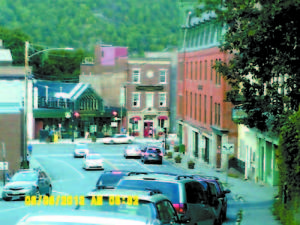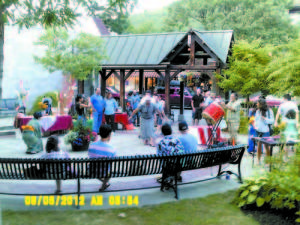Almost home: Who wins and loses in our Mall America?
By Michael T. Corrigan
BN Columnist
Tumbled into several long blocks beside the broad Connecticut River, Brattleboro, Vt. boasts an extraordinarily packed downtown, with several handsome stone public buildings interspersed along commercial streets of red brick. It is an attractive city, only slightly threadbare from long use, and further decorated with some larger old homes standing along the hillside, tree-lined streets that radiate out away from the river. When I visited on a recent Friday evening, the downtown streets were crowded with people, most of them young, and a folk festival enlivened a vest pocket park. I wanted to move in immediately.
Closing in on the end of my truncated trip around America’s northeast quadrant, I knew this vision of civic union could not be all there was to Brattleboro. After cresting the green forested up-and-down of Route 7 from Bennington at the state’s western border and finding little commercial development on the ridges before the Brattleboro city limits, I decided to look north on Route 5 for what simply had to be there. I mean, I may have been in Vermont, but I was still in America. A mile or so of slightly eroding older development gave way to the usual vista of sensory overload, for suddenly here in all their jumbled lack of splendor sprawled two large malls with huge parking lots before them, and cars and more cars and trucks and more cars, and a bewildering array of aerial signs for Comfort Inn, America’s Best Value Inn, a McDonald’s, a

COMPACT DOWNTOWN of Brattleboro, Vt. was alive last Friday night because there were more pedestrians moving around than cars. That’s a downtown’s job, to get people out of their cars and mingling, socially and commercially.
Ninety-Nine, a Burger King, a Wendy’s, two unimpressive banks, a KFC, a couple of auto marts with their attendant auto parts shops in train, all the architecture in your basic metal (or, for all I could tell) cardboard box mode, fake brick or brick and plastic, with nothing built with any consideration of nor in relation to anything else in sight. The style was what might be called SAFE — Standard American Fungibile Economy — which is to say, architecture built with no style at all, and for one purpose. And yes, I stayed at the Motel 6, because they’d left the light on for me. They weren’t the only ones on that mile-plus-long strip who had.
Since I was a traveler, and these strips service travelers (as well as numerous refugee recreational shoppers from the host inner city), essentially these places were built especially for me and my kind. I suppose I should be grateful, but I really wish they hadn’t gone to all the trouble. But this confusion and profusion is the pattern, everywhere the same, de rigeur in non-rural America, and creeping inexorably in even there: we live in roadscapes now, not landscapes, paved-over countryside built not for people, but for automobiles, with the stopping places private emporia for consumers only, and no assembly spaces for citizens, those who used to be known, quaintly, as “the general public.â€
These spaces are essentially inhuman, and much of the money that supports them comes from elsewhere — only to be funneled right back out to some other elsewhere, to corporate offices on the edge of some suburb that everyone who works there had to drive to, themselves. (On their way in passing the Value Inn, a KFC, a Burger King, auto malls, etc.…) Local places are losing not only their distinctiveness but their vitality, too. And Americans eat the same hamburgers under the same signs and when we hit the road again we imagine we are doing well. In Every Man For Himself America, any rumored shared fate is discounted. Losers best not complain.

PEACE DEMONSTRATION in Brattleboro featured a big red drum, paper cranes, dancing and costumes. Celebration in a small park livened up the downtown area considerably. (Corrigan Photos)
Big is everything in American business now, because big is profitable — for the big guys at least. Big business and its pocketed politicians want it this way. Big is, literally, the law. We talk long about entrepreneurship, but so many obstacles are thrown in front of the little guy, it’s mostly empty talk, and small-scale entrepreneurship is much more difficult than it should be in a supposed free market. We have an automobile culture, and it’s unsustainable, but in order to survive, existing smaller businesses decide they must service the automobile, too, and they move out to the strip. And we keep building new commercial strips — and new houses away from downtown too — and welcome in those big box chain stores, because, by God, that’s what “growth†is. It’s a pyramid scheme; if it ever stopped the whole cheesy house of cards would collapse. The growth economy requires more growth to keep its overheated engines roaring, and to keep the money flowing back to corporate headquarters from 20,000 American towns and cities.
We really need to rethink the whole culture, starting with transportation, but including housing patterns and livability of neighborhoods, modes of development, our national and even our local energy policies, and much, much more. Despite warning signs that the long, self-indulgent American feast powered by cheap energy is coming to an end, and has been running on fumes for at least three decades, we’re still living pretty high off a pretty low hog. Those who tell you that the banquet can go on forever are lying to you, and probably to themselves.
In the end, I went out on my journey this summer looking for the truly local, but everywhere I went I competed for road space with a million other strangers in a million other cars, and I found even the more unaffected downtowns weakened by service stations and by “modernized†storefronts and attendant parking lagoons, and mostly surviving on second-tier business like curio shops, tattoo parlors, service businesses and convenience stores. There weren’t many robust Brattleboros — though I did find a few. Thriving or not, the outskirts always housed new strip malls and big box malls and maybe one old mall already closed after 15 years, and there would be parking for fast-fooders, who were definitely not fasting, and for fast cars, always the cars. The downtowns were distinctive mostly to the extent that they had resisted the erosive effects of modernization and the hollowing-out caused by the chains on the outskirts.
One night, I slept in my car in a giant Walmart parking lot in Oneonta, N.Y. Four or five big rigs, two RVs, and about five other private cars sat scattered around the outer limits of the lot. So there I was, a certified loser in Mall America, where The House will tell you there’s a winner every time, and for a cheap buy-in, too. But I wasn’t the only one who had passed on the deal, and wished he could somehow drop out of the game. There are way, way, way more of us in today’s America than the five or 10 losers who overnighted at that Walmart.



